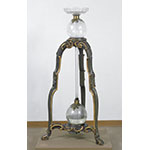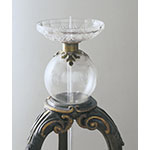This type of fountain, described by Hero of Alexandria, was a fairly popular apparatus in physics collections up to the early twentieth century. A carved and decorated wooden tripod supports two stacked glass globes fitted with brass collars. The upper globe carries an engraved glass cup. A tube connected to a small hole in the cup runs through the upper globe and into the lower. A second tube connects the two globes. A third, shorter tube runs from the middle of the upper globe to the center of the cup, ending in a nozzle. To operate the apparatus, one must fill the upper globe with water. The fountain is primed by pouring water in the cup. The water flows into the lower globe, expelling air into the upper globe, where it is compressed. As a result, the water in the upper globe is driven by the air pressure up the shortest tube and spurts from the nozzle, falling back into the cup. The fountain continues to function until the lower globe is full and the upper empty. Hero's fountains—made in different designs and of various dimensions and materials—or similar devices such as intermittent fountains were sometimes used as eye-catching table centerpieces for dispensing wine or colored beverages. The construction features of this specimen are typical of the French machines described by Jean-Antoine Nollet. Provenance: Lorraine collections.











